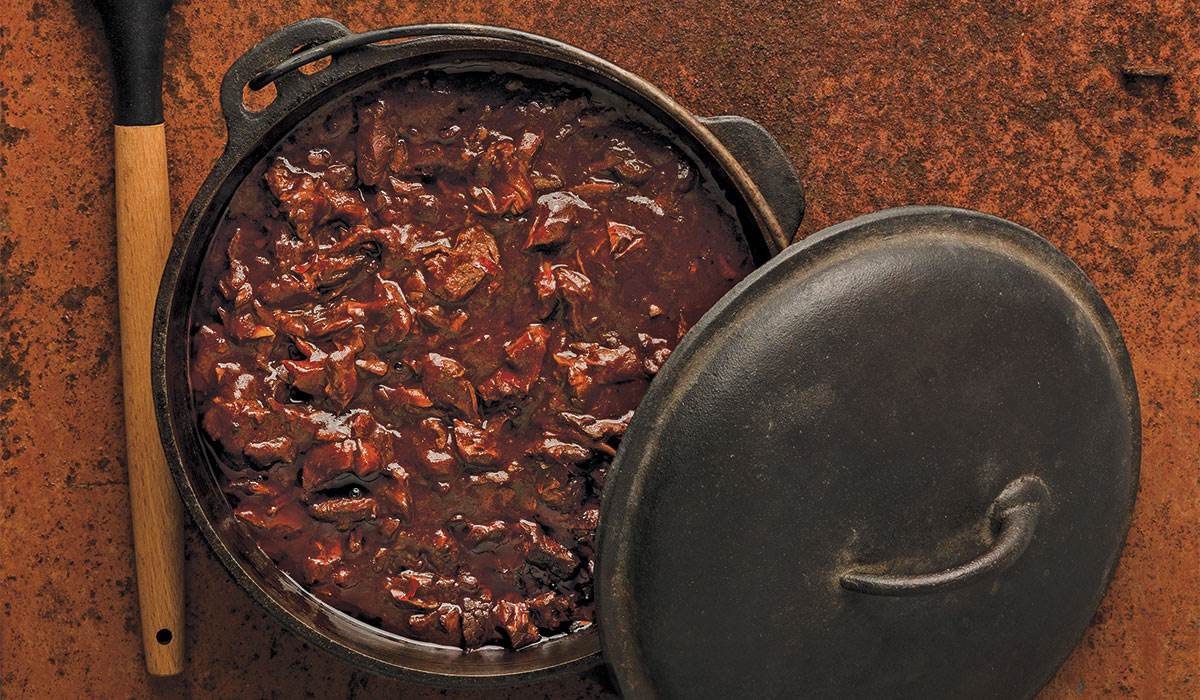Chili Colorado
A rich, spicy, and tasty alternative to traditional chili
A rich, spicy, and tasty alternative to traditional chili


Every part of the country seems to have its own variation on the classic chili recipe. If you ask a Midwesterner what goes into a proper batch of chili, the answer might include ground beef, chili seasonings, tomato sauce, and a dash of hot sauce. Add beans to your chili in Texas and you'll get taken out behind the barn and disciplined. I like just about all of the chili recipes I've tried, but I've got a soft spot for Chili Colorado.
You may have walked by dried red peppers in your local market and wondered what to do with them. The cool thing about these peppers is that they can be stored indefinitely and brought to life in 20 or 30 minutes. Split them open, remove the seeds and stems, soak the peppers in boiling-hot water, and process in a blender or food processor with some of the soaking liquid.
Although I do occasionally use ground meat in my chili, I prefer it chunky. As the cubes of meat simmer in the sauce, they will get tender enough to break apart with minimal finger pressure. If, after a few hours of simmering, the meat is still not tender, make sure that there is sufficient liquid in the pot, cover, and keep cooking. Meat from a large adult Canada goose will take longer to become tender than meat from an average-sized duck.
Yields: 6 to 8 servings
Puddle ducks, divers, geese, and even coots can be used in this chili, which isn't named for the state, but for the Spanish word that means "colored red." I like a combination of meaty ancho and mild guajillo chilis, but you can use whatever varieties are available.
INGREDIENTS
PREPARATION
1. Heat 2 quarts of water in a large pot over medium-high heat. Once boiling, add peppers, reduce heat to low, and simmer for 20 to 25 minutes or until peppers soften. Drain the peppers, reserving the liquid. Transfer the peppers and 1 cup of the reserved liquid to a blender or food processor. Add oregano and cumin. Process until mixture is smooth. If necessary, add a little more of the reserved liquid.
2. Heat vegetable oil in a large pot over medium-high heat. Season the meat with salt and pepper and brown in the hot oil. If the pot is crowded, brown the meat in smaller batches. Once the meat is well browned, add garlic and onions. Cook until onions are translucent. Sprinkle flour over contents of the pot and stir to coat evenly. Reduce heat to medium and cook for 3 to 4 minutes.
3. Stir in processed chilis and stock and bring to a boil. Reduce heat to low, cover, and simmer for 2 to 3 hours or until meat is very tender. After the first hour, check to make sure that the meat is covered with liquid. Add additional stock or reserved liquid if needed.
4. Season to taste with salt and pepper. Serve in bowls with tortillas and toppings on the side.
Dried red chili peppers can be found in most grocery stores. Once you remove the stems and seeds and soak the peppers in hot water, they are ready to use.
Diced avocado, shredded cheese, diced onions, sliced jalapeño peppers, fresh cilantro
Chili, in all of its incarnations, is one of the country's most popular dishes. This simple variation, slow-cooked for hours, yields tender meat and hearty sauce. Serve it with tortillas and toppings of your choice.
There are around 50,000 different types of peppers in the world, and they vary widely in spiciness. A pepper's heat can be measured on the Scoville scale, devised by the American pharmacist Wilbur Scoville in 1912. Each pepper species is assigned a number of Scoville Heat Units (SHUs). The higher the number, the spicier the pepper. A basic bell pepper has a SHU value of 0. The Carolina Reaper, the world's hottest pepper, has a value of 2,200,000 SHUs. The relatively mild guajillo and ancho peppers used in this recipe score around 3,750 and 1,250, respectively.
Ducks Unlimited uses cookies to enhance your browsing experience, optimize site functionality, analyze traffic, and deliver personalized advertising through third parties. By continuing to use this site, you agree to our use of cookies. View Privacy Policy